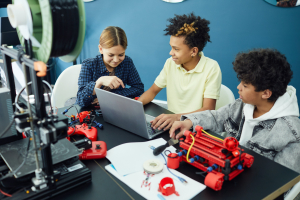Top 10 Unique Cause and Effect Essay Topics and Samples
Explore unique cause-and-effect dynamics with our "Top 10 Unique Cause and Effect Essay Topics and Samples." Uncover intriguing narratives for a fresh ... read more...perspective.
-
Essay topic: Causes and Effects of the "Fear of Missing Out" (FOMO) in the Digital Age
Answer:
In our hyper-connected digital age, the "Fear of Missing Out" (FOMO) has become a prevalent and influential phenomenon. This essay explores the causes behind FOMO and its far-reaching effects on individuals in the era of social media and constant connectivity.
One of the primary causes of FOMO is the pervasive influence of social media platforms. The curated and filtered content displayed on platforms like Instagram, Facebook, and Twitter often depict idealized versions of others' lives, fostering a sense of inadequacy and the fear of being left out of exciting experiences. The constant stream of updates and activities from friends and influencers can intensify the fear that one's own life is not as engaging or fulfilling.
Additionally, the instant access to information and real-time updates contributes to the fear of missing out on news, events, or trends. As individuals scroll through their feeds, the fear that they are not up-to-date with the latest happenings can create anxiety and a sense of being disconnected from the world.
The effects of FOMO are diverse and impactful. Socially, it can lead to increased stress, anxiety, and a diminished sense of self-worth as individuals compare their lives to the highlight reels of others. In extreme cases, FOMO can contribute to social isolation as individuals withdraw from real-world interactions to immerse themselves in the digital realm.
Furthermore, the fear of missing out can drive impulsive behavior. Individuals may make hasty decisions to attend events, purchase products, or engage in activities solely to avoid the perceived negative emotions associated with missing out. This impulsive behavior can have financial implications and contribute to a cycle of temporary satisfaction followed by regret.
In conclusion, the causes of FOMO in the digital age are rooted in the constant exposure to curated content and the fear of being left behind. The effects include emotional distress, social isolation, and impulsive behavior. Recognizing the impact of FOMO is crucial for fostering a healthier relationship with technology and social media, promoting self-esteem, and embracing the authenticity of individual experiences.

Photo by Andrea Piacquadio via pexels 
Photo by Marina Shatskikh via pexels -
Essay topic: The Causes and Consequences of Virtual Reality and Augmented Reality on Human Perception
Answer:
In the rapidly advancing landscape of technology, virtual reality (VR) and augmented reality (AR) have emerged as transformative tools, offering immersive experiences that blur the lines between the digital and physical worlds. This essay explores the causes behind the consequences of VR and AR on human perception, shedding light on the multifaceted impacts of these technologies.
One of the primary causes of the consequences associated with VR and AR is the alteration of sensory input. In virtual environments, users are presented with artificial stimuli that can override or manipulate their sensory perceptions. This can lead to a disconnection between the information received by the senses and the actual physical surroundings, impacting how individuals perceive space, time, and the reality they inhabit.
The effects of VR and AR on human perception are diverse. On the positive side, these technologies can enhance learning experiences, allowing users to visualize complex concepts in fields like education, medicine, and architecture. However, the immersive nature of VR and AR can also lead to negative consequences, such as a blurring of the boundaries between reality and fiction. This may result in challenges distinguishing between virtual and real-world scenarios, potentially leading to disorientation and cognitive dissonance.
Moreover, the prolonged use of VR and AR can impact social interactions. The immersive nature of these technologies may lead to isolation as individuals prefer virtual experiences over face-to-face communication. This shift in social dynamics can have implications for mental health, with potential consequences such as feelings of loneliness and a disconnect from the physical world.
In conclusion, the causes of the consequences associated with VR and AR lie in the alteration of sensory input and the immersive nature of these technologies. The effects range from positive enhancements in learning to potential challenges in distinguishing between virtual and real experiences, impacting social interactions and mental well-being. Recognizing and understanding these consequences are essential for navigating the evolving relationship between humans and immersive technologies in the modern era.

Photo by Bradley Hook via pexels 
Photo by Sebastian Voortman via pexels -
Essay topic: The Causes and Effects of Online Dating in Young People
Answer:
In recent years, the landscape of romantic relationships has undergone a significant transformation with the rise of online dating platforms. This essay delves into the causes behind the growing prevalence of online dating among young people and explores the multifaceted effects it has on their lives.
One of the primary causes of the surge in online dating among young people is the digitalization of social interactions. The pervasive use of smartphones and the increasing reliance on the internet have shifted many aspects of life online, including the way individuals seek romantic connections. The accessibility and convenience offered by online dating platforms provide an attractive alternative to traditional methods of meeting potential partners.
The effects of online dating on young people are extensive. On the positive side, these platforms broaden the pool of potential matches, allowing individuals to connect with people beyond their immediate social circles. This increased access to diverse individuals fosters cultural exchange, facilitates connections based on shared interests, and provides a platform for those who may find traditional dating settings challenging.
However, the effects are not solely positive. Online dating can contribute to a sense of superficiality, where initial judgments are often based on curated profiles and photos. This can lead to challenges in establishing genuine connections, as individuals may prioritize appearances over deeper compatibility factors. Additionally, the anonymity of online interactions can sometimes lead to misrepresentations and a lack of authenticity in self-presentation.
Furthermore, online dating may impact traditional social dynamics. The convenience of these platforms might discourage face-to-face interactions, potentially hindering the development of essential social skills. The shift towards digital connections could also influence the pace at which relationships progress, with some individuals opting for quick, online connections rather than investing time in longer-term, in-person interactions.
In conclusion, the causes of the surge in online dating among young people are rooted in the digitalization of social interactions. The effects range from increased accessibility and cultural exchange to challenges in authenticity and potential impacts on traditional social dynamics. Recognizing these causes and effects is crucial for understanding the evolving landscape of modern relationships and fostering healthy connections in the digital age.

Photo by cottonbro studio via pexels 
Photo by cottonbro studio via pexels -
Essay topic: Causes and Effects of the Minimalist Lifestyle Trend
Answer:
In recent years, the minimalist lifestyle trend has gained considerable traction, influencing individuals to embrace simplicity, decluttering, and intentional living. This essay explores the causes that have led to the rise of the minimalist lifestyle and examines its far-reaching effects on people's well-being and the environment.
One of the primary causes behind the minimalist lifestyle trend is a reaction to consumerism. In a world inundated with advertisements and a constant influx of products, people are increasingly seeking alternatives that prioritize experiences over possessions. The minimalist movement advocates for a deliberate reduction in material possessions, encouraging individuals to question the necessity of their belongings and focus on what truly adds value to their lives.
The effects of the minimalist lifestyle are profound and multifaceted. On a personal level, adopting a minimalist approach often leads to reduced stress and increased mental well-being. The decluttering process allows individuals to prioritize what truly matters to them, creating a sense of purpose and simplicity in their daily lives. Moreover, embracing minimalism can foster a healthier relationship with material goods, reducing the constant desire for more and promoting contentment with what one already possesses.
Environmentally, the minimalist lifestyle has positive effects on sustainability. By discouraging excessive consumption and promoting mindful purchasing decisions, minimalism contributes to the reduction of waste and the environmental impact of production. Choosing quality over quantity and favoring experiences over material possessions aligns with a more sustainable and eco-friendly lifestyle.
However, the minimalist lifestyle trend also has potential challenges. The pressure to conform to a certain aesthetic or to fit within a particular definition of minimalism may lead to feelings of inadequacy or exclusion. Additionally, the trend may inadvertently contribute to consumerism if individuals simply replace their possessions with new, trendy minimalist items.
In conclusion, the causes of the minimalist lifestyle trend stem from a desire for simplicity in response to consumerism. The effects include personal well-being, a shift towards sustainable living, and potential challenges related to conformity. Recognizing and understanding these causes and effects is essential for individuals seeking a balanced and intentional approach to living in the modern world.

Photo by Paula Schmidt via pexels 
Photo by Max Rahubovskiy via pexels -
Essay topic: Causes and Effects of the "Helicopter Parenting" Phenomenon
Answer:
In recent years, the term "helicopter parenting" has gained prominence, describing a style of parenting characterized by an overinvolved and excessive focus on a child's activities. This essay explores the causes that have led to the emergence of helicopter parenting and examines its consequences on both parents and their children.
One of the primary causes of the helicopter parenting phenomenon is the increasing competitiveness in education and career fields. In an era where success is often equated with academic achievements and extracurricular accomplishments, parents may feel compelled to micromanage their children's lives to ensure they have a competitive edge. This fear of falling behind in a highly competitive society drives parents to be excessively involved in every aspect of their child's development.
The effects of helicopter parenting are multifaceted and can have a significant impact on the well-being of both parents and children. On the positive side, children may initially benefit from the close attention and involvement of their parents, experiencing academic success and structured environments. However, the long-term effects can be detrimental, as children raised under helicopter parenting may struggle with decision-making, problem-solving, and developing a sense of independence.
For parents, the consequences often include high levels of stress, burnout, and strained relationships with their children. The relentless pursuit of perfection for their children's sake can lead to anxiety and an inability to let go. Moreover, helicopter parenting may hinder the parent-child relationship, as children may feel overwhelmed, micromanaged, and unable to assert their autonomy.
Additionally, the phenomenon may perpetuate a cycle of dependence, as children raised under helicopter parenting may struggle to navigate the challenges of adulthood independently. The lack of opportunities to make choices, face consequences, and learn from mistakes can hinder their development of crucial life skills.
In conclusion, the causes of helicopter parenting stem from societal pressures and a desire for children to succeed in a competitive environment. The effects include short-term academic success but long-term challenges in developing independence and a balanced parent-child relationship. Recognizing and understanding these causes and effects is crucial for parents seeking a healthier, more balanced approach to raising their children in a rapidly changing world.

Photo by J carter via pexels 
Photo by Andrea Piacquadio via pexels -
Essay topic: Causes and Effects of Puns and Wordplay in Language Development
Answer:
Puns and wordplay, with their clever twists on language, have long been recognized as more than mere sources of humor; they play a substantial role in language development. This essay explores the causes behind the prevalence of puns and wordplay and examines their far-reaching effects on language skills and cognitive development.
One of the primary causes of the use of puns and wordplay in language development is the innate human fascination with language creativity. From an early age, individuals are exposed to linguistic playfulness through rhymes, riddles, and word games, creating an environment that encourages exploration and experimentation with language. This playful engagement serves as a natural and enjoyable way for individuals, particularly children, to interact with and comprehend language structures.
The effects of puns and wordplay on language development are numerous and significant. Linguistic creativity stimulates cognitive processes, fostering critical thinking and problem-solving skills. The mental agility required to comprehend and create wordplay enhances cognitive flexibility, an essential aspect of cognitive development in both children and adults.
Moreover, exposure to puns and wordplay promotes vocabulary expansion and linguistic proficiency. Engaging with language in playful contexts encourages individuals to explore the multiple meanings and nuances of words, enhancing their understanding of language intricacies. This not only contributes to a richer vocabulary but also sharpens language comprehension skills.
Furthermore, the use of puns and wordplay has social and cultural effects on language development. Shared linguistic playfulness fosters social bonds and a sense of belonging within communities. Individuals who engage in wordplay contribute to a shared cultural repertoire, reinforcing the importance of language as a tool for communication, expression, and cultural identity.
In conclusion, the causes of puns and wordplay in language development are rooted in the innate human fascination with language creativity. The effects encompass cognitive development, vocabulary expansion, and social connectivity. Recognizing and understanding these causes and effects shed light on the vital role that puns and wordplay play in fostering a robust and dynamic language development process.

Photo by Markus Winkler via pexels 
Photo by Sara via pexels -
Essay topic: The Cause and Impact of Technology on Workplace Productivity
Answer:
In the contemporary professional realm, the symbiotic relationship between technology and workplace productivity has become undeniable. This essay explores the causes driving the integration of technology into the workplace and examines its profound effects on employees and organizational efficiency.
One of the primary causes of the pervasive influence of technology in the workplace is the quest for efficiency and competitiveness. Organizations recognize that adopting technological solutions can streamline processes, reduce manual workload, and enhance overall productivity. The relentless pursuit of staying ahead in a fast-paced business environment propels companies to invest in cutting-edge technologies to remain agile and effective.
The impact of technology on workplace productivity is multifaceted and transformative. The automation of routine tasks, made possible by advancements in artificial intelligence and machine learning, enables employees to redirect their efforts towards more complex and value-added aspects of their roles. This shift not only improves individual productivity but also contributes to the overall innovation and creativity within organizations.
Communication technologies have revolutionized the way teams collaborate. Digital platforms, video conferencing tools, and project management software facilitate seamless communication and coordination among employees, irrespective of geographical locations. This connectivity fosters a more efficient exchange of ideas, accelerates decision-making processes, and allows for the swift resolution of challenges.
Despite these positive impacts, the widespread adoption of technology in the workplace also gives rise to challenges. The constant connectivity may lead to information overload and potential burnout. The expectation for employees to be continuously available, even beyond traditional working hours, blurs the boundaries between personal and professional life.
In conclusion, the causes of the integration of technology into the workplace are rooted in the pursuit of efficiency and competitiveness. The impact encompasses increased productivity, enhanced collaboration, but also challenges related to work-life balance. Recognizing and balancing these factors is crucial for organizations seeking to harness the full potential of technology while ensuring the well-being of their workforce. As technology continues to evolve, its influence on workplace dynamics will undoubtedly shape the future of work.

Photo by ROMAN ODINTSOV via pexels 
Photo by Ketut Subiyanto via pexels -
Essay topic: The Causes and Impact of Political Instability on Economic Development
Answer:
Political stability is a cornerstone for economic growth and development in any nation. This essay explores the causes behind political instability and examines its far-reaching effects on a country's economic development.
One of the primary causes of political instability is governance challenges, such as corruption, lack of transparency, and ineffective institutions. When citizens perceive their government as corrupt or when institutions fail to address their needs, it often leads to discontent, protests, and political unrest. This lack of confidence in governance becomes a breeding ground for instability, hindering economic progress.
The impact of political instability on economic development is profound. Investor confidence is one of the first casualties during times of political unrest. Uncertainty about the political climate makes investors hesitant to commit capital, inhibiting foreign direct investment and stalling domestic economic projects. This lack of investment directly impedes economic growth and development.
Moreover, political instability often results in a decline in infrastructure development. Long-term projects crucial for economic advancement, such as roads, bridges, and energy facilities, may be postponed or abandoned due to political uncertainty. This dearth of infrastructure hampers the efficiency of industries and impedes the overall economic progress of a nation.
Additionally, political instability can lead to inflation and currency depreciation. The uncertainty surrounding political situations can prompt citizens and businesses to hoard goods and foreign currency, exacerbating economic volatility. Inflation erodes the purchasing power of the population, and a depreciating currency can increase the cost of imports, impacting trade balances and economic stability.
Furthermore, political instability may cause brain drain as skilled professionals seek more stable environments abroad, depriving the nation of essential expertise needed for economic development. The cycle of political instability can perpetuate a negative feedback loop, hindering the nation's ability to attract and retain talent.
In conclusion, the causes of political instability often stem from governance challenges. The impact is extensive, affecting investor confidence, infrastructure development, inflation, currency stability, and the talent pool within a country. Recognizing the interconnectedness of political stability and economic development is crucial for nations aspiring to achieve sustained growth and prosperity. Efforts to address governance issues and promote stability are fundamental steps toward fostering a conducive environment for economic advancement.

Photo by Alfo Medeiros via pexels 
Photo by August de Richelieu via pexels -
Essay topic: The Causes and Impact of Attention Deficit Disorders on Children
Answer:
Attention Deficit Hyperactivity Disorder (ADHD) is a neurodevelopmental disorder that affects a significant number of children worldwide. This essay explores the causes behind Attention Deficit Disorders and examines the far-reaching effects on the lives of affected children.
One of the primary causes of Attention Deficit Disorders is believed to be a combination of genetic and environmental factors. Children with a family history of ADHD are more likely to develop the disorder, suggesting a genetic predisposition. Additionally, exposure to environmental risk factors during pregnancy, such as maternal smoking, alcohol use, or exposure to toxins, may contribute to the development of ADHD.
The impact of Attention Deficit Disorders on children is extensive and multifaceted. Academic challenges are one of the prominent effects, as children with ADHD often struggle with concentration and focus, leading to difficulties in completing tasks and assignments. This academic underperformance can impact their self-esteem and hinder their overall educational progress.
Social relationships are another area profoundly affected by ADHD. The impulsivity and hyperactivity associated with the disorder can create challenges in forming and maintaining friendships. Children with ADHD may struggle to regulate their behavior in social settings, leading to misunderstandings and potential social isolation.
Furthermore, the emotional well-being of children with Attention Deficit Disorders can be compromised. The frustration and sense of failure resulting from difficulties in academic and social spheres may contribute to anxiety and depression. Moreover, untreated ADHD may persist into adolescence and adulthood, leading to ongoing challenges in various aspects of life, including education, employment, and interpersonal relationships.
In conclusion, the causes of Attention Deficit Disorders involve a complex interplay of genetic and environmental factors. The impact on affected children includes academic struggles, challenges in social relationships, and potential emotional difficulties. Recognizing and addressing ADHD early in a child's life through appropriate interventions, support, and understanding are crucial steps toward mitigating the long-term effects and fostering a more positive trajectory for their development.

Photo by Katerina Holmes via pexels 
Photo by Ksenia Chernaya via pexels -
Essay topic: The Cause and Impact of Mindfulness Meditation on Academic Performance
Answer:
In the fast-paced academic environment, students often face stress, anxiety, and challenges in maintaining focus. This essay explores the causes behind the integration of mindfulness meditation into academic settings and examines its profound effects on students' academic performance.
One of the primary causes of the adoption of mindfulness meditation in academic settings is the increasing awareness of the mental health challenges students encounter. Pressures to excel academically, coupled with external factors such as social pressures and personal issues, contribute to stress and anxiety. Mindfulness meditation offers a holistic approach to address these challenges by promoting mental well-being and emotional resilience.
The impact of mindfulness meditation on academic performance is multifaceted. One of the significant effects is the reduction of stress and anxiety levels among students. Mindfulness practices emphasize being present in the moment, cultivating a non-judgmental awareness of thoughts and feelings. This can lead to a decrease in the physiological and psychological symptoms of stress, allowing students to approach academic tasks with a clearer and calmer mindset.
Improved focus and attention are additional positive outcomes of mindfulness meditation. Regular practice has been linked to enhanced cognitive abilities, including sustained attention and working memory. As students develop the ability to concentrate more effectively, they may experience increased productivity in their academic endeavors.
Furthermore, mindfulness meditation can contribute to better emotional regulation. By fostering self-awareness and emotional intelligence, students become better equipped to navigate challenges, both academically and personally. This emotional resilience can positively impact their overall well-being and adaptability in various situations.
In conclusion, the causes of integrating mindfulness meditation into academic settings are rooted in addressing students' mental health challenges. The impact encompasses stress reduction, improved focus, and enhanced emotional regulation, all of which contribute to a more positive and conducive environment for academic performance. Recognizing the value of mindfulness practices in fostering well-rounded students is essential for educational institutions seeking to promote not only academic success but also holistic personal development.

Photo by Ivan Samkov via pexels 
Photo by Ivan Samkov via pexels































